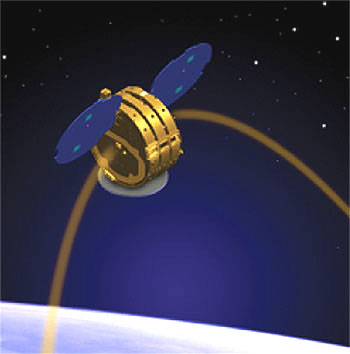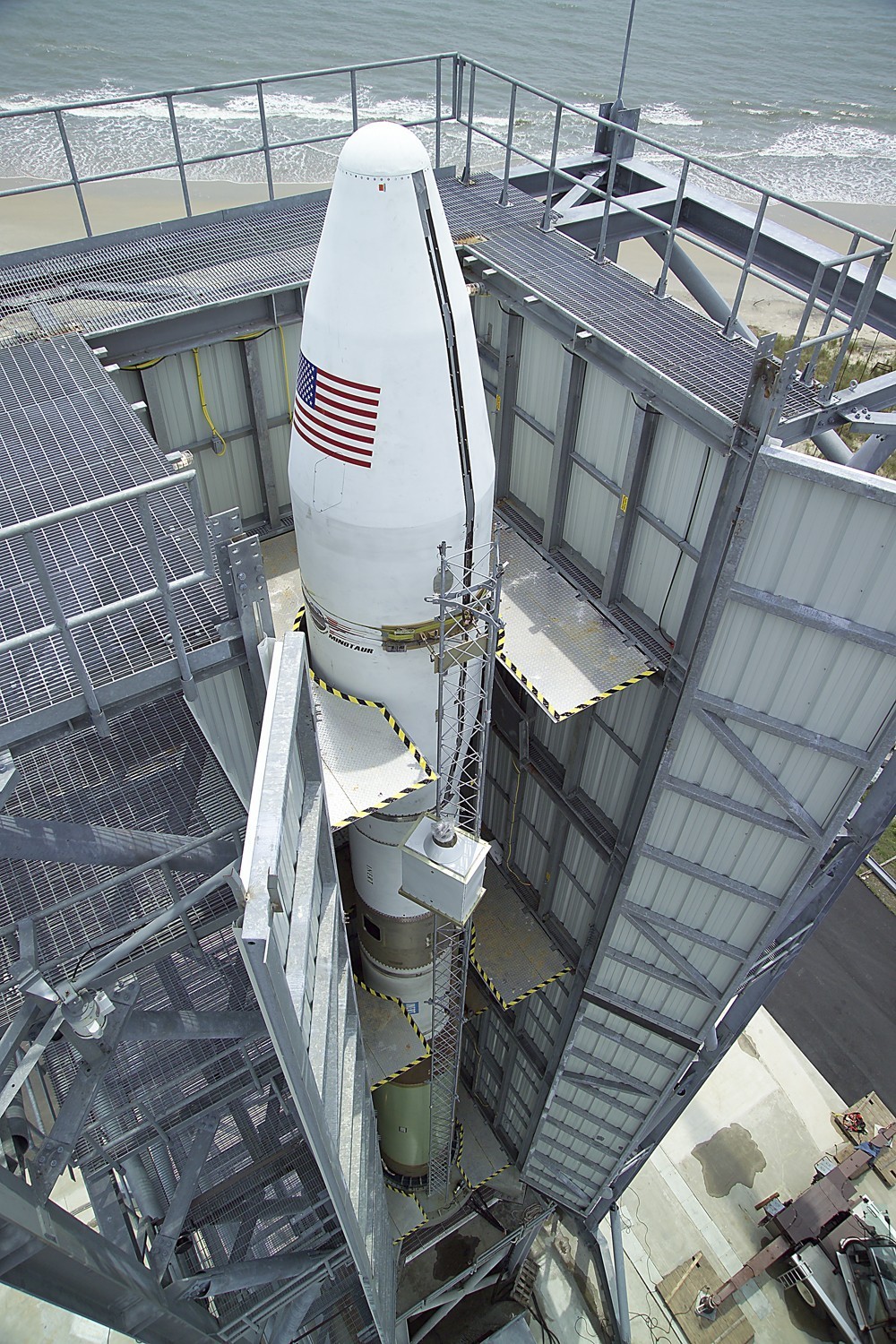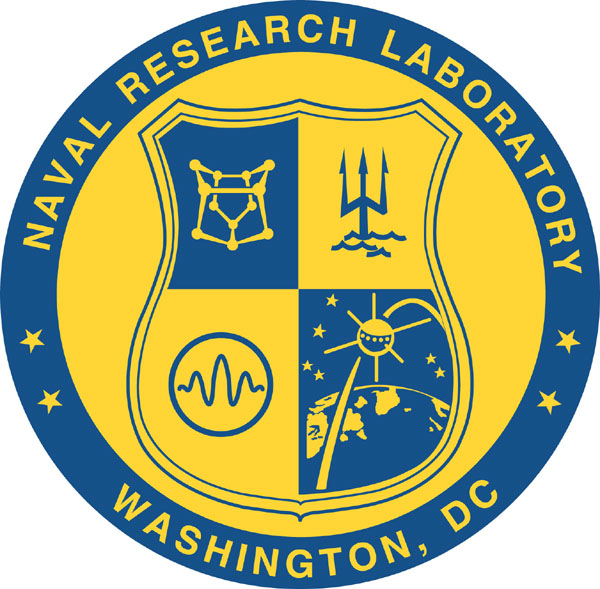|
Tactical Satellite Program
During the second half of 2002, the Naval Research Laboratory studied the tactical application of space assets. Relatively new technologies and processes in the areas of microsatellites, affordable and quick-response launch vehicles, and the classified SIPRNet (Secret Internet Protocol Router Network) made tactical use of space assets possible in the relatively near term. The DoD's Office of Force Transformation (OFT) agreed with the core findings of the study and decided to start an Operationally Responsive Space (ORS) Initiative consisting of a series of experiments. TacSat-1 is the first experiment in this OFT initiative. The TacSat-1 experiment received go-ahead on 7 May 2003. The TacSat series of experimental spacecraft are designed to allow military commanders on a battlefield to request and obtain imagery and other data from a satellite as it passes overhead. Collected data will be delivered to field commanders in minutes rather than hours or days. All TacSats have ... [...More Info...] [...Related Items...] OR: [Wikipedia] [Google] [Baidu] |
TacSat-1
TacSat-1 was an experimental satellite built by the Naval Research Laboratory (NRL) on behalf of the United States Department of Defense (DoD) Office of Force Transformation (OFT). It was the planned payload of the sixth launch of the SpaceX Falcon 1. It was however never launched into space. The second satellite in the series, TacSat-2, launched before TacSat-1 and this led to the cancellation of TacSat-1's launch. TacSat-1 would have carried a variety of experimental payloads. Much of the payload software was implemented through the use of bash scripts operating on the "Copperfield-2" general-purpose computer system aboard the spacecraft. Purpose The TacSat series of experimental spacecraft are designed to allow military commanders on a battlefield to request and obtain imagery and other data from a satellite as it passes overhead. Collected data will be delivered to field commanders in minutes rather than hours or days. The sensor on TacSat-1 could collect color images sha ... [...More Info...] [...Related Items...] OR: [Wikipedia] [Google] [Baidu] |
Office Of Force Transformation
The United States Department of Defense Office of Force Transformation (OFT) was established October 29, 2001 in the Office of the Secretary of Defense. Secretary of Defense Donald Rumsfeld called for the creation of this new office to support his transformation vision along with President George W. Bush’s broad mandate to transform U.S. military capabilities. The transformation process intends to challenge the status quo with new concepts for American defense to ensure an overwhelming and continuing competitive advantage. The Director, Force Transformation serves as advocate, focal point, and catalyst for transformation among the Department, reporting directly to the Secretary and Deputy Secretary of Defense. On October 1, 2006, the Office of Force Transformation was disestablished, and its functions spread between the Office of the Under Secretary of Defense for Policy, and the Office of the Under Secretary of Defense for Acquisition, Technology, and Logistics. Leadership V ... [...More Info...] [...Related Items...] OR: [Wikipedia] [Google] [Baidu] |
Reconnaissance Satellites Of The United States
In military operations, reconnaissance or scouting is the exploration of an area by military forces to obtain information about enemy forces, terrain, and other activities. Examples of reconnaissance include patrolling by troops ( skirmishers, long-range reconnaissance patrol, U.S. Army Rangers, cavalry scouts, or military intelligence specialists), ships or submarines, crewed or uncrewed reconnaissance aircraft, satellites, or by setting up observation posts. Espionage is usually considered to be different from reconnaissance, as it is performed by non-uniformed personnel operating behind enemy lines. Often called recce (British, Canadian and Australian English) or recon (American English), the word for this activity has at its root the associated verb ''reconnoitre'' or ''reconnoiter''. Etymology The word from the Middle French ''reconoissance''. Overview Reconnaissance conducted by ground forces includes special reconnaissance, armored reconnaissance, amp ... [...More Info...] [...Related Items...] OR: [Wikipedia] [Google] [Baidu] |
TacSat-6
TacSat-6 is a U.S. military experimental technology and communication satellites. The Operationally Responsive Space Office (ORS) funded the launch that will be performed by the United States Army Space and Missile Defense Command (SMDC). The spacecraft was launched on 6 December 2013, at 07:14:30 UTC, on a Atlas V 501 launch vehicle from Vandenberg Air Force Base, SLC-3E Space Launch Complex 3 (SLC-3) is a launch site at Vandenberg Space Force Base that consists of two separate launch pads. SLC-3E (East) is currently used by the Atlas V launch vehicle, while SLC-3W (West) has been demolished. Launches from Vand .... Mission TacSat-6 is equipped that can be used for any combination of communications. Part of its capability is rapid (within 24 hours) reallocation to different theaters worldwide, in support of unexpected operations. Command and control of TacSat-6 is performed by the United States Army Space and Missile Defense Command (SMDC). Design All Tac ... [...More Info...] [...Related Items...] OR: [Wikipedia] [Google] [Baidu] |
TacSat-5
TacSat-5 is a planned fifth satellite in a series of U.S. military reconnaissance satellites. The project will be managed by the Air Force Research Laboratory in cooperation with the Operationally Responsive Space Office of the Department of Defense Department of Defence or Department of Defense may refer to: Current departments of defence * Department of Defence (Australia) * Department of National Defence (Canada) * Department of Defence (Ireland) * Department of National Defense (Philippin .... The TacSat satellites are all designed to demonstrate the ability to provide real-time data collected from space to combatant commanders in the field. In January 2009, AFRL released a Broad Agency Announcement for the development of TacSat-5. At that time, the mission still had not been specified and the bus was to be developed based on AFRL's Plug-and-Play avionics standards. References Reconnaissance satellites of the United States Air Force Research Laboratory projects ... [...More Info...] [...Related Items...] OR: [Wikipedia] [Google] [Baidu] |
Launch Vehicle
A launch vehicle or carrier rocket is a rocket designed to carry a payload (spacecraft or satellites) from the Earth's surface to outer space. Most launch vehicles operate from a launch pads, supported by a launch control center and systems such as vehicle assembly and fueling. Launch vehicles are engineered with advanced aerodynamics and technologies, which contribute to large operating costs. An orbital launch vehicle must lift its payload at least to the boundary of space, approximately and accelerate it to a horizontal velocity of at least . Suborbital vehicles launch their payloads to lower velocity or are launched at elevation angles greater than horizontal. Practical orbital launch vehicles are multistage rockets which use chemical propellants such as solid fuel, liquid hydrogen, kerosene, liquid oxygen, or Hypergolic propellants. Launch vehicles are classified by their orbital payload capacity, ranging from small-, medium-, heavy- to super-heavy lift ... [...More Info...] [...Related Items...] OR: [Wikipedia] [Google] [Baidu] |
Minotaur (rocket Family)
The Minotaur is a family of United States solid fuel launch vehicles derived from converted Minuteman and Peacekeeper intercontinental ballistic missiles (ICBM). They are built by Northrop Grumman via contract with the Air Force Space and Missile Systems Center's Space Development and Test Directorate (SMC/SD) as part of the Air Force's Rocket Systems Launch Program which converts retired Intercontinental Ballistic Missiles into space and test launch systems for U.S. government agencies. Three variants of the Minotaur are currently in service. The Minotaur I is an orbital launch system used to launch small satellites into low Earth orbit (LEO). The Minotaur II is a target launch vehicle (TLV), also known as Chimera, used for suborbital flights, often as a target for tracking and anti-ballistic missile tests. The Minotaur IV is a more capable LEO launch system. The Minotaur V is designed to reach higher orbits, including geostationary transfer orbit (GTO) and trans-l ... [...More Info...] [...Related Items...] OR: [Wikipedia] [Google] [Baidu] |
Operationally Responsive Space
The Operationally Responsive Space Office (ORS Office) is a joint initiative of several agencies within the United States Department of Defense (DoD). The "stand up" of the office took place 21 May 2007 at Kirtland Air Force Base. The first director of the ORS Office was Col. Kevin McLaughlin, who was also dual-hatted as commander of the Space Development and Test Wing located at Kirtland. The ORS Office focuses on providing quick-response tactical space-based capabilities to the warfighter utilizing smaller satellites, such as the Tactical Satellite Program and smaller launch vehicles. Organizations that have been involved in ORS activities include the United States Space Force, United States Army, the United States Navy, DARPA, the National Reconnaissance Office, the Missile Defense Agency and NASA. Leadership Col. John Anttonen took over as Director of the ORS Office in February 2013. Previous directors Peter Wegner was director of ORS from May 2008. History The Joint ORS Off ... [...More Info...] [...Related Items...] OR: [Wikipedia] [Google] [Baidu] |
SIPRNet
The Secure Internet Protocol Router Network (SIPRNet) is "a system of interconnected computer networks used by the U.S. Department of Defense and the U.S. Department of State to transmit classified information (up to and including information classified SECRET) by packet switching over the 'completely secure' environment". It also provides services such as hypertext document access and electronic mail. As such, SIPRNet is the DoD's classified version of the civilian Internet. SIPRNet is the SECRET component of the Defense Information Systems Network. Other components handle communications with other security needs, such as the NIPRNet, which is used for nonsecure communications, and the Joint Worldwide Intelligence Communications System (JWICS), which is used for Top Secret communications. Access According to the U.S. Department of State Web Development Handbook, domain structure and naming conventions are the same as for the open internet, except for the addition of a sec ... [...More Info...] [...Related Items...] OR: [Wikipedia] [Google] [Baidu] |
Microsatellite (spaceflight)
A small satellite, miniaturized satellite, or smallsat is a satellite of low mass and size, usually under . While all such satellites can be referred to as "small", different classifications are used to categorize them based on mass. Satellites can be built small to reduce the large economic cost of launch vehicles and the costs associated with construction. Miniature satellites, especially in large numbers, may be more useful than fewer, larger ones for some purposes – for example, gathering of scientific data and radio relay. Technical challenges in the construction of small satellites may include the lack of sufficient power storage or of room for a propulsion system. Rationales One rationale for miniaturizing satellites is to reduce the cost; heavier satellites require larger rockets with greater thrust that also have greater cost to finance. In contrast, smaller and lighter satellites require smaller and cheaper launch vehicles and can sometimes be launched in multip ... [...More Info...] [...Related Items...] OR: [Wikipedia] [Google] [Baidu] |
Naval Research Laboratory
The United States Naval Research Laboratory (NRL) is the corporate research laboratory for the United States Navy and the United States Marine Corps. It was founded in 1923 and conducts basic scientific research, applied research, technological development and prototyping. The laboratory's specialties include plasma physics, space physics, materials science, and tactical electronic warfare. NRL is one of the first US government scientific R&D laboratories, having opened in 1923 at the instigation of Thomas Edison, and is currently under the Office of Naval Research. As of 2016, NRL was a Navy Working Capital Fund activity, which means it is not a line-item in the US Federal Budget. Instead of direct funding from Congress, all costs, including overhead, were recovered through sponsor-funded research projects. NRL's research expenditures were approximately $1 billion per year. Research The Naval Research Laboratory conducts a wide variety of basic research and applied ... [...More Info...] [...Related Items...] OR: [Wikipedia] [Google] [Baidu] |






